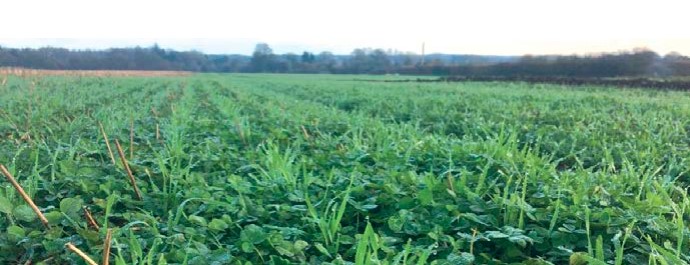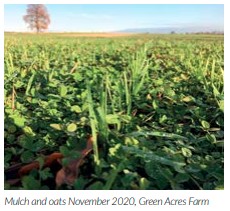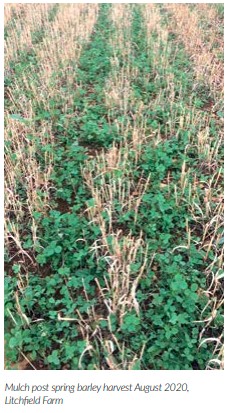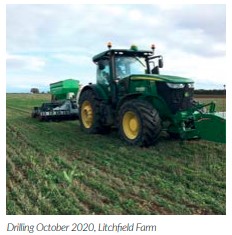Written by Dominic Amos, Crops Researcher at the Organic Research Centre

As based on information found on Agricology (www.agricology.co.uk)
Reducing tillage and chemical inputs can be beneficial for soil and the environment, so could a permanent clover understorey acting as a ‘living mulch’, moving towards a perennial soil cover, offer a practical solution to reducing inputs and having more sustainable cropping systems?
This is the question being investigated by a group of arable farmers attempting to implement the system for input reduction through an Innovative Farmers Field Lab. Inputs in this case could be agrochemicals and fertilisers or tillage and diesel, depending on the current farming system. These are the two starting points of the group who are either already practicing long term conventional no-till looking to reduce chemical inputs or established organic farmers looking to reduce tillage. There is an imperative from both perspectives but whilst both farming systems can learn from each other, the challenges for each of making an alternative system work are quite different due to the respective starting points.
What is a living mulch?
A living mulch (LM) system includes aspects of several common farming practices and concepts such as cover cropping, intercropping, undersowing, and mulching, with the system building upon these approaches with full integration as a cropping system. In practical terms it requires the establishment of a perennial forage legume to provide protection for the soil as a (semi-)permanent ground cover common to perennial cropping systems such as top fruit or viticulture. It is rarely used in annual cropping systems due to the competition with the cash crop so the question is, is it compatible with annual arable cropping? The LM approach differs from the well-known organic reduced tillage systems with the roller crimper pioneered by Rodale where the idea is to terminate high biomass cover crops to provide a dead mulch that helps suppress weeds for establishing cash crops. In truth this system relies on certain climatic conditions generally not experienced in the UK.
Services and benefits
The LM system can be expected to deliver a number of key ecological services to the agroecosystem including nitrogen (N) accumulation, weed suppression, enhanced soil physical characteristics (and trafficability), soil protection, catch cropping function, self-regulation of pests and disease, increased soil fertility and increased biological diversity. At this stage it is also worth considering that many organic farms already have weeds that provide some of the ecosystem services but with less control over species, so the mulch could be thought of as a ’designated weed.’¹
The two key services that need to be delivered for a LM system to best contribute to agricultural productivity are weed control and N supply.Living mulches offer a potential alternative and sustainable strategy for these two provisions, although the amount of N made available for the cash crop and level of weed control will be greatly influenced by management and by the season. Conventional notill systems may require supplemental N fertiliser to maintain crop yields. These two services offer an insight into the complexity of the system and the trade-offs (not necessarily unavoidable). There is a strong correlation between the mulch biomass and weed suppression and N accumulation services but high biomass will offer stronger competition against the cash crop.

This management balancing act between cash and cover crop growth throughout the season is the fundamental challenge to a working LM system – in order to harness the benefits of this permanent cover whilst limiting the risks to productivity. If enhanced soil health, increased biodiversity (above and below ground) and reduced emissions can also be delivered, then a more sustainable and resilient farming system is the prize on offer. There is a word of warning at this point since much of the research already conducted in this area including recent work at Stockbridge Technology Centre through the DIVERSify and TRUE projects demonstrate large and potentially unsatisfactory grain yield losses from arable LM systems that will require careful thought and management to make successful.
Enhancing beneficial interactions and managing competition
The ecological concepts that underpin the cereal-forage legume system are known as niche complementarity and facilitation and the system works on the principle of functional diversity. In theory this means the two ‘parts’ of the system work in harmony but in practice, particularly from the organic perspective, making the system work has proved elusive. This is a complex issue but a key factor is the interactions of the cash and the cover crop, and the ability to manage and manipulate the competitive advantage of the cereal. In fact, from an agroecological perspective, boosting the cash crop and weakening the cover crop at key times in the growing season is a real challenge especially since, as previously mentioned, weakening the mulch actually contradicts its key service provisions. Small doses of N fertiliser and herbicides can selectively weaken the clover and hand the competitive advantage to the cereal but of course these options are unavailable for organic farmers.
Farmer-led trials with Innovative Farmers
There are several areas that are being explored by farmers through the field lab:
1. Mulch species and establishment
2. Cash crop species and establishment
3. Mulch management (both externally and in crop)
Mulch and crop species selection
Different combinations of approaches are being tested with the farmers – utilising their knowledge of the context of their farms and systems and taking wider considerations into account to choose the most appropriate options for them. This will facilitate the peer to peer exchange and progress on living mulch best practice. In the field lab trials the farmers have used a mix of wild white and smallmedium leaf clover recommended by Cotswold Seeds, that has been selected to remain prostrate and provide persistence but with limited longer term competition against the crop. The clovers were established through undersowing into cereal crops in spring 2020.

Direct drilling cereal crops into the pre-established stand of clover took place last October with winter oats and rye selected for their competitive abilities. How and when, or even if, to manage the mulch is a key question being explored. There are opportunities to mow or graze before drilling the cash crop, or even during the foundation phase of cereal growth in the late winter. One of the most interesting questions is whether the mulch needs to be selectively managed later during the growing season and how this might be done? An option being considered is inter-row mowing, though commercial equipment is not yet available.

In conclusion
This fine balance of managing and manipulating the dynamics of a cash and cover crop to the advantage of the cash crop whilst maximising the services from the cover crop is what in the end will determine the successful implementation of what is on paper a sustainable and resilient way to farm the land – albeit one that will require a system redesign approach. In the end the system will rely on the knowledge and ingenuity of the farmers and the peer to peer learning to turn the theory into successful practice.
Agricology is an independent collaboration of over 40 of the UK’s leading farming organisations sharing ideas on sustainable farming practices. We feature farmers working with natural processes to enhance their farming system, and have a wide range of farmer videos on our YouTube page. We also share the latest scientific learnings on agroecology with the farming community from our network of researchers. Our website hosts over 400 articles on different agroecological practices. Subscribe to the newsletter or follow us on social media @agricology to keep up to date and share your questions and experiences with the Agricology community.
